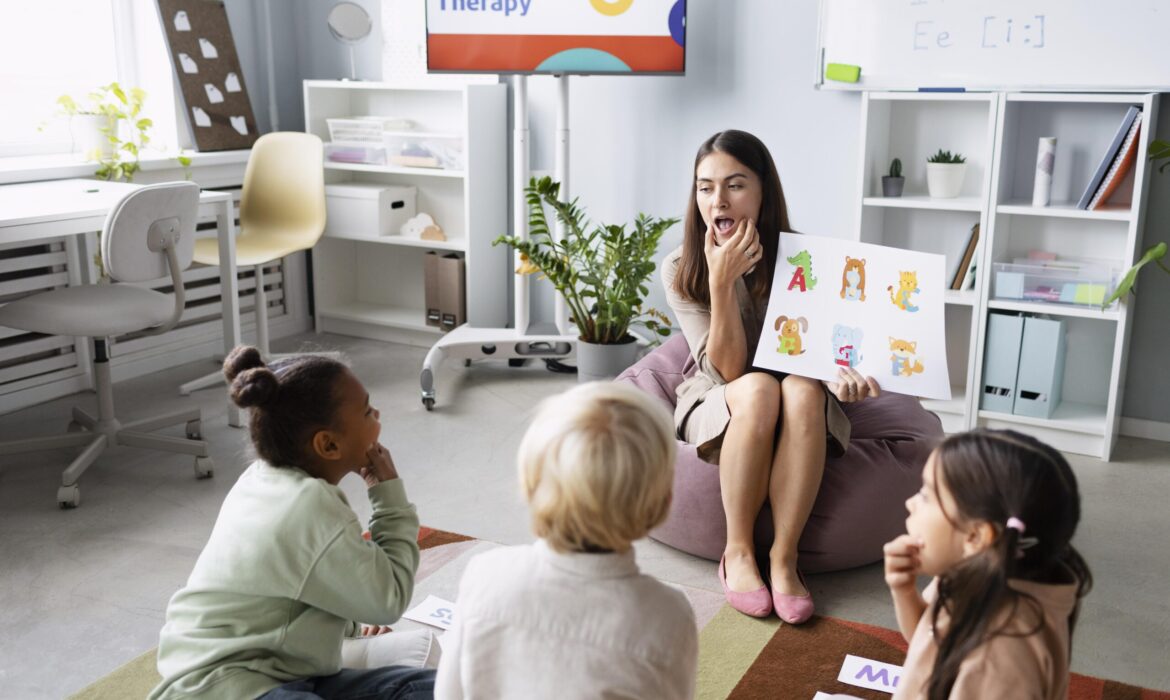Speech Therapy Milestones: What Progress Looks Like At Different Ages
Speech and language development are at the heart of how children connect, express themselves, and make sense of the world. Every new sound, gesture, or word is a small but powerful step toward communication. For children on the autism spectrum, this progress can look different, sometimes slower or unexpected, but always meaningful. Recognising these unique paths helps parents celebrate growth instead of comparing timelines. Tracking autism speech therapy milestones gives families a clearer picture of where their child is now and how to support the next step forward.
At AUTISMSTEP, we understand that every child communicates in their own way and at their own pace. Our team provides personalised speech therapy for autism in Singapore, designed to nurture progress through encouragement, play, and evidence-based strategies.
Building Blocks Of Communication: How Children Learn To Speak And Communicate
Speech is about how we make sounds and form words, while language is about understanding and using those words to share ideas and emotions. Some children may speak clearly but struggle to build sentences, while others understand what’s said to them yet find it difficult to respond. Speech therapists assess both receptive language, which involves understanding, and expressive language, which focuses on using words to communicate. For neurodiverse children, progress may look different, but every small step forward is meaningful and worth celebrating.
Speech Therapy Milestones For Children With Autism: Understanding Progress At Every Age
Every child’s communication journey unfolds in its own unique way. In speech therapy, progress isn’t measured by how quickly a child reaches a milestone, but by how steadily they grow in confidence, understanding, and expression. By looking at how communication typically develops at different ages, parents can better recognise and celebrate their child’s progress. The following guide outlines what speech therapy milestones often look like for children with autism.
Ages 2-3: Building the Foundation for Communication
In the earliest years, communication begins long before words. Babies start by cooing, babbling, and responding to familiar voices. Therapists focus on helping little ones engage through eye contact, imitation, and turn-taking. Early autism speech therapy activities often use play, music, and gestures to build comfort and encourage vocalisation. Even small steps, like responding to their name or pointing to an object, are powerful signs of progress at this stage.
Ages 3–5: Expanding Words and Early Conversations
During the preschool years, children begin to use words more intentionally. They start naming objects, expressing needs, and combining words into short sentences. In speech therapies for autism in Singapore, sessions often focus on strengthening both understanding (receptive language) and expression (expressive language). Therapists introduce games, stories, and sensory activities to help children expand vocabulary and learn how to take turns in conversation. This is also when articulation therapy becomes important, as children learn to form sounds more clearly. Progress may look like improved pronunciation, increased word use, or more consistent engagement with family and peers.
Ages 6–10: Strengthening Language for Learning and Social Growth
As children enter school, speech therapy goals often shift toward supporting learning and social interaction. Children start to understand more complex instructions, describe events, and express ideas or emotions. Therapists help them practice sequencing stories, asking questions, and interpreting nonverbal cues. Bilingual therapy is often valuable for families who use multiple languages at home, helping children grow more confident and skilled in communicating in both languages. Milestones here include clearer speech, stronger storytelling, and better participation in classroom communication and play.
Ages 11 and Above: Refining Social and Academic Communication
Older children and teens continue to develop more advanced communication skills. They begin to understand humour, idioms, and the subtle rules of conversation. Speech therapy at this stage often focuses on pragmatic (social) language, problem-solving, and emotional expression. Teens learn to adapt their speech for different situations, such as talking with teachers, friends, or in interviews. Milestones may include improved confidence in group discussions, more natural back-and-forth conversations, and better self-advocacy.
However, it’s important to remember that autism speech therapy milestones vary widely from one child to another. Some children make quick gains, while others progress gradually over time. The key is consistency, patience, and celebrating each success, no matter how small. At AUTISMSTEP, therapists tailor each plan to match a child’s specific needs and strengths, ensuring that communication becomes not just a skill, but a joyful, empowering experience.
Conclusion:
Every child’s communication journey unfolds in their own time and in their own way. What matters most is not how fast progress happens, but how confidently a child learns to express, connect, and be understood. With the right guidance and consistent support, children on the autism spectrum can make meaningful strides in communication and social interaction. At AUTISMSTEP, our dedicated therapists create personalised speech therapy plans that celebrate every success and nurture steady growth through evidence-based, compassionate care. If you’re looking to support your child’s communication development, contact us today.
What Is An Autism Milestone Chart — And Why It Matters
Milestones are like gentle guideposts that help families understand a child’s development, marking growth in areas such as communication, social interaction, motor skills and independence. For children on the spectrum, progress may not follow the same sequence as typical charts, which is why an autism milestone chart is so important. Instead of comparing one child to another, it focuses on recognising individual strengths and unique patterns of growth. Parents and professionals often use these charts to track changes, celebrate progress, and identify areas where extra support may be helpful. For families exploring autism resources in Singapore, AUTISMSTEP provides thorough guidance and practical tools, with a focus on meaningful progress that honours every child’s journey.
What Is A Milestone Chart And How Does It Work?
A milestone chart is a tool that helps families and professionals track important areas of child development such as speech and language, motor coordination, social skills, and cognitive growth. Traditional charts are usually designed with neurotypical development in mind, so they often follow a set sequence of expected achievements. It recognises that each child’s journey is unique and provides a flexible way to understand growth without comparison to standard timelines.
An autism milestone chart focuses on areas that matter most for children with autism. These include communication, both verbal and non-verbal, social interaction such as building relationships and responding to others, sensory responses like managing sounds or textures, and daily living skills such as eating independently or following routines. What makes the chart especially supportive is that it respects the reality that progress does not always move in a straight line. A child may develop quickly in one area while taking more time in another, and every step forward is worth celebrating. This approach gives parents and professionals a practical guide that highlights strengths, supports challenges, and honours the individuality of each child.
Why Autism Milestone Charts Matter For Parents, Professionals And Children With Autism:
For Parents:
An autism milestone chart provides clarity without creating pressure or judgment. Parents of children on the spectrum often wonder whether their child is progressing as expected, but traditional developmental charts rarely capture the unique pace of autistic growth. This can cause unnecessary stress or doubt. A tailored milestone chart changes the perspective by highlighting progress in ways that truly matter, such as making eye contact, trying a new activity, or using a new word. These small but meaningful steps are recognised and celebrated, which helps families focus on their child’s abilities. The chart also encourages collaboration between parents and professionals, giving everyone a shared picture of how best to support the child’s next steps.
For Professionals:
Therapists, teachers, and healthcare providers use milestone charts as a foundation for creating individualised support plans. By tracking development in areas such as communication, social skills, sensory responses, and daily living, professionals can see where a child is thriving and where extra support may be needed. This makes interventions far more effective because they are built around the child’s actual progress rather than general expectations. Approaches like ABA-VB therapy, which combines Applied Behaviour Analysis with Verbal Behaviour strategies, become even more impactful when guided by insights from a milestone chart. Professionals can set goals that are realistic, measurable, and meaningful, ensuring that therapy addresses both challenges and strengths in a balanced way.
For Children:
The greatest impact of an autism milestone chart is often felt by the children themselves. It provides a positive framework where progress is visible and valued, even if development does not follow a straight path. Skills may appear in one area while taking longer in another, and the chart reflects this natural variation without labelling it as failure. Each achievement, no matter how small, is celebrated, helping children feel proud of their growth. This recognition builds confidence, encourages motivation, and fosters a sense of accomplishment. Instead of being defined by what they have not yet achieved, children are supported for who they are and the progress they are making at their own pace.
AUTISMSTEP combines professional expertise with compassion and practical support. By offering home-based Autism therapy sessions, and individualised learning programs, we help families find the right tools and environment for growth. By using evidence-based methods including ABA-VB therapy, our focus remains on celebrating milestones, empowering families, and giving every child the chance to thrive in their own unique way.
Conclusion:
An autism milestone chart is more than a tracking tool; it is a way to recognise and celebrate the unique journey of every child. It shifts the focus from comparison to meaningful progress, giving parents reassurance, guiding professionals with clarity, and helping children build confidence in their own growth. By honouring individuality, milestone charts create opportunities to support strengths, address challenges, and make every achievement count. Families do not have to walk this path alone.
At AUTISMSTEP, we provide personalised support through tailored learning programs, and flexible home-based therapy sessions. Our mission is to empower families and help every child reach their fullest potential. Reach out to AUTISMSTEP today and discover how we can support your child’s unique journey.
Why School shadowing Programmes Are Essential For Children With Autism
Starting school is a big milestone. It can feel like climbing a mountain instead of a simple step forward. School readiness isn’t just about knowing the alphabet; it’s about handling routines, following instructions, and connecting with others. For children on the spectrum, these skills often need extra support. A strong school shadowing programme gives these children the tools they need to transition smoothly.
AUTISMSTEP offers structured social and school shadowing classes that combine evidence-based strategies with real-world practice to help children build confidence, independence, and resilience for long-term success.
Common Challenges Children With Autism Face In School:
Let’s face it, school isn’t always easy for many kids, it can feel overwhelming, especially when they’re not fully prepared. Making friends and joining in conversations can be confusing when reading social cues doesn’t come naturally. Many children also struggle with transitions, switching from one activity to another or dealing with a sudden change in routine can throw off their whole day. On top of that, sitting still, staying focused, or understanding multi-step instructions can turn even simple tasks into major challenges.
Therefore, preparing children with autism for school is crucial. Give kids the right tools to handle sensory overload, connect with others, manage classroom routines, and it can completely change their school experience. Early intervention for autism truly makes a difference. With the right support in place early on, children can walk into school not just ready, but confident and equipped to thrive.
How School Shadowing Programmes Can Set Your Child Up For Success:
From social interactions to coping with sensory input, the classroom brings a range of new demands. Without the right preparation, these challenges can quickly become barriers. Below are the key reasons why school readiness programmes are vital for your child.
Bridges the Gap Between Therapy and the Classroom
Children with autism often spend their early years in one-on-one or small group therapy settings, which are carefully controlled and personalized. But school is a different world–it’s fast-paced, social, and often unpredictable. A well-designed school shadowing programme helps bridge this gap. It gives children a chance to practice their skills in real classrooms, helping them adjust to group learning, shared attention, and structured routines. This transition time is critical for building confidence before the demands of formal education begin.
Supports Social and Communication Development
Making eye contact, sharing space, turn-taking, or even asking for help can be challenging for many. School shadowing offers structured opportunities to build these abilities through guided play, peer interaction, and supported communication. Children learn how to work in a group, interact with classmates, and use language in practical, meaningful ways, all essential for thriving in a school setting.
Reduces Anxiety
Unfamiliar surroundings, new people, and changing routines can cause high levels of stress. School shadowing gently exposes children to these elements ahead of time, helping them become comfortable with classroom layouts, school routines, and group expectations. This kind of gradual exposure reduces anxiety and helps children walk into school on the first day feeling more secure and in control.
Improves Emotional and Behavioural Regulation
Many children with autism struggle to manage emotions and behaviours, particularly in stimulating or unpredictable environments. In school, this can look like meltdowns, avoidance, or difficulty following instructions. School shadowing directly addresses these challenges by teaching children how to self-regulate, handle transitions, and manage frustration. Through repetition and positive reinforcement, they learn coping tools that help them stay focused and calm in the classroom.
Increases the Chances of Long-Term Academic Success
If children start school unprepared, they’re more likely to struggle from the beginning and making up that ground later isn’t easy. We recommend strengthening foundational academic behaviours like attention, following directions, completing tasks, and staying engaged first. When children feel confident and prepared, they’re more engaged and motivated, and that foundation sets the stage for long-term academic success.
Encourages Independence and Life Skills
Being school-ready isn’t just about reading or counting, it’s also about knowing how to manage personal belongings, follow a timetable, and transition from one activity to another. School shadowing in Singapore often includes practical life skills as part of the curriculum. Whether it’s zipping a backpack, queuing for snacks, or cleaning up after an activity, children gain the everyday independence they’ll need to function confidently in a school environment.
Complements Ongoing Autism Therapy in Singapore
Parents often wonder how school shadowing fits with their current therapy plans. The answer: perfectly! If your child is already receiving autism therapy in Singapore, school shadowing programmes act as a valuable extension. These reinforce therapy goals in a more natural, group-based environment, allowing children to generalize their skills beyond the therapy room. These programmes amplify progress and help children apply what they’ve learned in real-world contexts.
Summary:
With the right support, starting school doesn’t have to feel overwhelming for your child. It can be a confident and comfortable new beginning. School shadowing gives children with autism the tools to manage daily routines, interact socially, and cope with the sensory and emotional challenges they might face in a typical classroom environment. It’s not just about preparing them for their first day, it’s about setting them up for long-term success. Early support leads to smoother transitions and a more positive school experience overall.
If you’re looking to give your child that head start, AUTISMSTEP is here for you. Our specialised school readiness classes combine expert strategies with real-world practice to help your child thrive. Visit AUTISMSTEP today!




